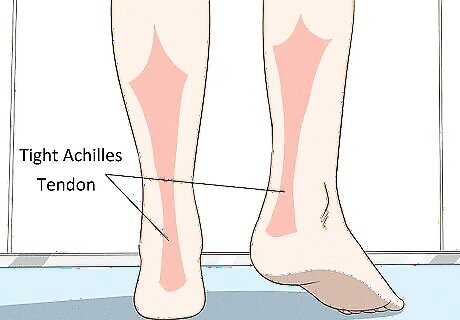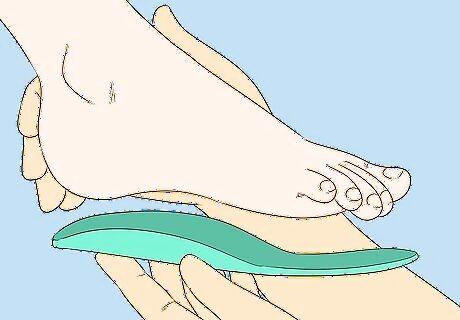
views
X
Trustworthy Source
National Health Service (UK)
Public healthcare system of the UK
Go to source
Although flat feet are normal in infants and toddlers, your arches typically develop during childhood. However, researchers say that flat feet can occur if your arches never form or they collapse because of an injury, obesity, aging, or a medical condition.[2]
X
Trustworthy Source
Mayo Clinic
Educational website from one of the world's leading hospitals
Go to source
Fortunately, you may be able to relieve the discomfort caused by your flat feet.
Understanding the Types of Flat Feet

Flat feet in children is normal. It’s normal for kids to have flat feet at least until the age of 5 years (and sometimes as late as 10 years) because it takes time for the bones, ligaments and tendons in the underside of the foot to form a supportive arch. As such, don't panic if your child has flat feet, especially if they don't seem to be causing pain or problems with walking or running — they will likely grow out of it, so no need to seek treatment and try to fix it. Do the flat surface test to determine flat feet. Moisten your feet and step onto a dry surface that shows your footprint. If the entire surface of your foot can be discerned from the print, then you have flat feet. A person with normal arches has a crescent of negative space on the inside (medial) part of their footprint due to lack of contact with the surface. Flat feet in children rarely cause pain.

Tight tendons can cause flat feet. A tight Achilles tendon from birth (congenital) puts too much pressure on the front 3/4 of the foot, preventing a normal springy arch from forming. The Achilles tendon connects the calf muscle to the heel. When it's too tight it causes the heel to lift off the ground prematurely during each step while walking, causing tension and pain underneath the foot. In this instance, the foot becomes flat while standing, but remains flexible while not weight bearing. The main treatment options for flexible flat feet with a congenitally short Achilles tendon are either an aggressive regimen of stretching or surgery, which are explained in more detail below. In addition to arch and heel pain, other common symptoms of flat feet include: calf, knee and/or back pain, swelling around the ankles, trouble standing on tiptoes, difficulty jumping high or running fast.

Rigid, flat feet are caused by bone deformity. A rigid, inflexible flat foot remains without an arch whether weight bearing or not. It's considered a "true" flat foot within medicine because the shape of the underneath of the foot remains unchanged at all times, regardless of activity. This type of flat foot is typically caused by bone malformations, deformity or fusions that prevent the arch from forming during childhood. As such, this type of flat foot can be present from birth, or acquired in adulthood due to a foot injury or disease, such as osteoporosis or inflammatory arthritis. A rigid flat foot often creates more symptoms because the entire biomechanics of the foot are altered. Rigid flat feet are most resistant to accommodative therapy such as shoe inserts, orthotics and physiotherapy.

Adult-acquired flat feet are often due to obesity. Another kind of flat feet is often referred to as adult-acquired, but it is usually due to overstretching / overuse / damage to the posterior tibial tendon, which runs from the calf muscle along the inside of the ankle and ends within the arch. The tendon is the most important soft tissue of the arch because it provides the most support. The most common cause of posterior tibial tendon overstretching is having to support too much weight (obesity) for too long, particularly if unsupportive footwear are typically worn. Flat feet is not always bilateral — it can occur in only one foot, especially after suffering a fractured ankle or foot. Adult-acquired flat feet often respond to accommodative therapy, but losing weight is often the key to fixing the problem.
Altering Flat Feet at Home

Wear more supportive shoes. Regardless of the type of flat feet you have, wearing shoes with good arch support is going to provide at least some benefit, and it might possibly provide total relief of your foot, leg or back symptoms. Try to find a comfortable walking or athletic shoe with substantial arch support, roomy toe box, firm heel counter and a flexible sole. Supporting your arches helps decrease tension in the posterior tibial and Achilles tendons. Avoid shoes with heels higher than 2 1/4 inches because it leads to short / tight Achilles tendons. However, wearing completely level shoes is not the answer either, because too much pressure is put on the heel, so wear shoes that are elevated in the heel by about 1/4 or 1/2 inch. Get fitted for shoes by a trained salesperson later in the day because that's when your feet are at their largest, usually due to swelling and slight compression of your arches.

Get custom made orthotics. If you have flexible flat feet (not completely rigid) and spend lots of time standing or walking, then consider a pair of custom made shoe orthotics. Orthotics are semi-rigid shoe inserts that support the arch of your foot and promote better biomechanics while standing, walking and running. By providing cushioning and some shock absorption, orthotics will also help reduce the likelihood of problems developing in other joints such as your ankles, knees, hips and lumbar spine. Orthotics and similar supports don't reverse any structural deformities of the foot nor can they reconstruct an arch by wearing them over time. Health professionals who make custom orthotics include podiatrists, as well as some osteopaths, physicians, chiropractors and physiotherapists. Wearing orthotics often requires taking the factory insoles out. Some health insurance plans cover customized orthotics, but if yours does not, then consider off-the-shelf orthopedic insoles — they are less expensive and may provide adequate arch support. In fact, they have been shown in some cases to be equally effective when compared to custom orthotics.

Lose weight If you are too heavy. If you are overweight (especially obese), then losing weight has a multitude of health benefits including taking the pressure off the bones, ligaments and tendons of your feet, as well as providing better blood flow to the area. Losing weight won't reverse rigidly flat feet, but it will positively impact other types of flat feet to some extent. For most women, consuming less than 2,000 calories daily will lead to some weekly weight loss even if you're only a mild exerciser. Most men will lose weight on a weekly basis if they consume less than 2,200 calories daily. Many obese people have flat feet and tend to over-pronate their ankles (the joints collapse and turn in), which then leads to a knock-knee posture. Sometimes women develop fallen arches during the late stages of pregnancy that then go away once their baby is born. To help promote weight loss, eat lean meat, poultry and fish, whole grains, fresh veggies and fruit and drink lots of purified water. Avoid sugary drinks such as soda pop.
Seeking Medical Treatments

Try some intensive physical therapy. If your flat feet have some flexibility in them (not rigid) and they are caused primarily by weak or tight tendons / ligaments, then you should consider some form of rehabilitation. A physiotherapist can show you specific and tailored stretches and strengthening exercises for your feet, Achilles tendons and calf muscles that can help to restore your arch and make it more functional. Physiotherapy is usually required 2-3x per week for 4-8 weeks to positively impact chronic foot problems. A common stretch for tight Achilles tendons involves placing your hands against a wall with one leg at a time outstretched behind you in a lunge-like position. Make sure you keep the outstretched foot flat on the floor to feel a stretch above your heels. Hold for about 30 seconds and repeat five to 10 times daily. A physiotherapist can tape your foot with sturdy tape that can help relieve symptoms by providing a temporary artificial arch. A physiotherapist can also treat inflamed and tender arches (called plantar fasciitis and a common complication of flat feet) with therapeutic ultrasound.

Consult a podiatrist. A podiatrist is a foot specialist who is familiar with all conditions and diseases of the feet, including pes planus. A podiatrist will examine your foot and try to determine if your flat feet are congenital (hereditary and from birth) or acquired as an adult. They will also look for any bone trauma (fractures or displacements), possibly with the help of x-rays. Depending on the severity of your symptoms and the cause of your flat feet, the podiatrist may recommend simple palliative care (rest, ice and anti-inflammatories during flare-ups), orthotic therapy, casting or bracing the foot, or some form of surgery. Adult-acquired flat feet affects women four times as often as men and tends to occur in later years (around 60). X-rays are great for seeing bone problems, but they are not diagnostic for soft tissue issues, such as those of the tendons and ligaments. Your podiatrist is trained for relatively minor operations of the feet, but more complex surgeries are typically the domain of orthopedic surgeons.

Talk to your doctor about surgical options. If your flat feet are causing you lots of problems and not significantly helped by supportive shoes, orthotics, weight loss or intensive physical therapy, then ask your family physician about potential surgical options. Your doctor may use a CT scan, MRI or diagnostic ultrasound to get a better idea of the soft tissues of your foot. For severe cases of highly rigid flat feet, especially if caused by tarsal coalition (an abnormal fusion of two or more bones in the foot), then surgery recommendation is highly likely. Surgery is also recommended for chronically tight Achilles tendons (typically a simple procedure to lengthen the tendon) or overly lax posterior tibial tendons (via tendon reduction or shortening). Your family doctor is not a foot, bone or joint specialist, so you will likely be referred to an orthopedic surgeon if surgery is required. Surgeons typically operate on one foot at a time so as not to incapacitate the patient and impact their lives too significantly. Possible complications from surgery include: failure of fused bones to heal, infections, reduced ankle / foot range of motion, chronic pain. Recovery times for surgery vary depending on the procedure (whether bones need to be broken or fused, tendons severed, or ligaments altered), but can last several months. Diseases that are contributive factors for flat feet include diabetes, osteoporosis, rheumatoid arthritis, and ligament laxity diseases such as Marfan or Ehlers-Danlos syndromes.




















Comments
0 comment